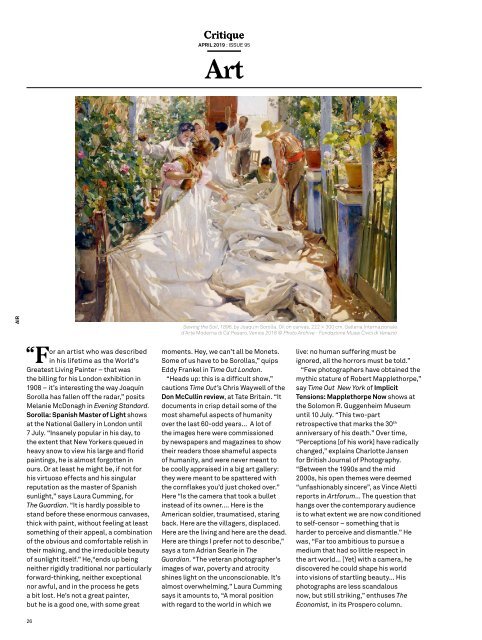Create successful ePaper yourself
Turn your PDF publications into a flip-book with our unique Google optimized e-Paper software.
Critique<br />
APRIL <strong>2019</strong> : ISSUE 95<br />
Art<br />
AIR<br />
or an artist who was described<br />
“Fin his lifetime as the World’s<br />
Greatest Living Painter – that was<br />
the billing for his London exhibition in<br />
1908 – it’s interesting the way Joaquín<br />
Sorolla has fallen off the radar,” posits<br />
Melanie McDonagh in Evening Standard.<br />
Sorolla: Spanish Master of Light shows<br />
at the National Gallery in London until<br />
7 July. “Insanely popular in his day, to<br />
the extent that New Yorkers queued in<br />
heavy snow to view his large and florid<br />
paintings, he is almost forgotten in<br />
ours. Or at least he might be, if not for<br />
his virtuoso effects and his singular<br />
reputation as the master of Spanish<br />
sunlight,” says Laura Cumming, for<br />
The Guardian. “It is hardly possible to<br />
stand before these enormous canvases,<br />
thick with paint, without feeling at least<br />
something of their appeal, a combination<br />
of the obvious and comfortable relish in<br />
their making, and the irreducible beauty<br />
of sunlight itself.” He,“ends up being<br />
neither rigidly traditional nor particularly<br />
forward-thinking, neither exceptional<br />
nor awful, and in the process he gets<br />
a bit lost. He’s not a great painter,<br />
but he is a good one, with some great<br />
Sewing the Sail, 1896, by Joaquín Sorolla. Oil on canvas, 222 × 300 cm. Galleria Internazionale<br />
d’Arte Moderna di Ca’ Pesaro, Venice 2018 © Photo Archive - Fondazione Musei Civici di Venezia<br />
moments. Hey, we can’t all be Monets.<br />
Some of us have to be Sorollas,” quips<br />
Eddy Frankel in Time Out London.<br />
“Heads up: this is a difficult show,”<br />
cautions Time Out’s Chris Waywell of the<br />
Don McCullin review, at Tate Britain. “It<br />
documents in crisp detail some of the<br />
most shameful aspects of humanity<br />
over the last 60-odd years... A lot of<br />
the images here were commissioned<br />
by newspapers and magazines to show<br />
their readers those shameful aspects<br />
of humanity, and were never meant to<br />
be coolly appraised in a big art gallery:<br />
they were meant to be spattered with<br />
the cornflakes you’d just choked over.”<br />
Here “Is the camera that took a bullet<br />
instead of its owner.... Here is the<br />
American soldier, traumatised, staring<br />
back. Here are the villagers, displaced.<br />
Here are the living and here are the dead.<br />
Here are things I prefer not to describe,”<br />
says a torn Adrian Searle in The<br />
Guardian. “The veteran photographer’s<br />
images of war, poverty and atrocity<br />
shines light on the unconscionable. It’s<br />
almost overwhelming.” Laura Cumming<br />
says it amounts to, “A moral position<br />
with regard to the world in which we<br />
live: no human suffering must be<br />
ignored, all the horrors must be told.”<br />
“Few photographers have obtained the<br />
mythic stature of Robert Mapplethorpe,”<br />
say Time Out New York of Implicit<br />
Tensions: Mapplethorpe Now shows at<br />
the Solomon R. Guggenheim Museum<br />
until 10 July. “This two-part<br />
retrospective that marks the 30 th<br />
anniversary of his death.” Over time,<br />
“Perceptions [of his work] have radically<br />
changed,” explains Charlotte Jansen<br />
for British Journal of Photography.<br />
“Between the 1990s and the mid<br />
2000s, his open themes were deemed<br />
“unfashionably sincere”, as Vince Aletti<br />
reports in Artforum... The question that<br />
hangs over the contemporary audience<br />
is to what extent we are now conditioned<br />
to self-censor – something that is<br />
harder to perceive and dismantle.” He<br />
was, “Far too ambitious to pursue a<br />
medium that had so little respect in<br />
the art world... [Yet] with a camera, he<br />
discovered he could shape his world<br />
into visions of startling beauty... His<br />
photographs are less scandalous<br />
now, but still striking,” enthuses The<br />
Economist, in its Prospero column.<br />
26

















